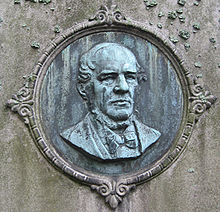- Christian Wilhelm Blomstrand
-
Christian Wilhelm Blomstrand 
Christian Wilhelm BlomstrandNacimiento 20 de octubre de 1826
Växjö, Småland, SueciaFallecimiento 5 de noviembre de 1897
Lund, SueciaCampo Químico Instituciones Universidad de Lund Alma máter Universidad de Lund Christian Wilhelm Blomstrand (20 de octubre de 1826 - 5 de noviembre de 1897) fue un mineralogista y químico sueco.
Blomstrand nació en Växjö, Suecia y estudió química en la Universidad de Lund, donde recibió su doctorado en 1850 y su habilitación en 1854. Después de una expedición a Spitsbergen y de ser profesor en la Escuela Técnica Primaria de Malmö,[1] [2] se convirtió en profesor de química de la Universidad de Lund en 1862.
Blomstrand fue elegido miembro de la Real Academia Sueca de Ciencias en 1861.
Publicaciones
- Blomstrand, Kristian Vilhelm (1869). Die Chemie der Jetztzeit: vom Standpunkte der electrochemischen Auffassung, aus Berzelius Lehre entwickelt. ISBN 9781144805102. http://books.google.de/books?id=Mm8MAQAAIAAJ.
- «Die Chemie der Jetztzeit vom Standpunkte der elektrochemischen Auffassung aus Berzelius Lehre entwickelt von C. W. Blomstrand. XIV. u. 417 S. Heidelberg, Carl Winter 1869». Archiv der Pharmazie 189: pp. 173. 1869. doi:.
Enlaces externos
- Blomstrand, Christian Wilhelm, Naturens grundämnen i deras inbördes ställning till hvarandra (Estocolmo 1875). Disponible en línea a través del Proyecto Runeberg. (en sueco)
Referencias
- ↑ House Of Commons, Great Britain. Parliament (1869). House of Commons papers. http://books.google.de/books?id=PQwTAAAAYAAJ&pg=RA1-PA5.
- ↑ «Christian Wilhelm Blomstrand». Berichte der deutschen chemischen Gesellschaft 30: pp. 3227. 1897. doi:.
- «Christian Wilhelm Blomstrand (1826–1897) Swedish chemist and mineralogist». Annals of Science 32: pp. 13. 1975. doi:.
- E. v. Meyer (1945). «Zur Erinnerung an Friedrich Stohmann und Christian Wilhelm Blomstrand». Journal für Praktische Chemie 56 (1): pp. 397–400. doi:.
- Weeks, Mary Elvira (1951). «The discovery of the elements: XVI. The rare earth elements». Journal of Chemical Education 9 (10): pp. 1751 – 1773. doi:.
Categorías:- Nacidos en 1826
- Fallecidos en 1897
- Químicos de Suecia
- Miembros de la Real Academia de las Ciencias de Suecia
Wikimedia foundation. 2010.
